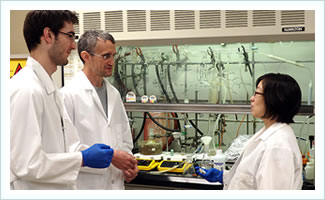
Translational life sciences research at the University of Kansas received another boost this summer from KU itself. Three faculty inventions received up to $50,000 each to help move these research discoveries from the laboratory to the marketplace.

The investments came from the Proof of Concept (POC) Fund, a program administered by KU Innovation and Collaboration, the university’s technology commercialization office. This is the program’s third year. Five awards were made in 2014 and four in 2013.
POC grants support research and development for up to one year in any area of innovation and technology, including electronics, software, communications, life sciences and engineering. During that time, the inventor works to make the technology more attractive for licensing. Funded projects require patent protection and a clearly identified commercial product or method.
“Our goal is to identify technologies with commercial potential and translate them to companies to create products,” said Julie Nagel, interim associate vice chancellor for innovation and entrepreneurship. “We have a number of promising technologies in our portfolio, so it’s a highly competitive process.”
Life science technologies and inventors receiving awards for 2015-16 are:
“Low Impedance Piezoelectric Composites for Long Bone Reconstruction Implants”
Lisa Friis, Mechanical Engineering; Paul Arnold, Neurosurgery, KU Medical Center. The invention uses direct current electrical stimulation to accelerate bone fusion and healing. A recent pilot study using sheep was successful. The POC award will be used to improve manufacturing methods and help identify other targeted orthopedic applications.
“NanoTor”
Laird Forrest, Pharmaceutical Chemistry. The invention, nano-hyaluronan rapamycin (NanoTor), targets breast cancer stem cells and delivers an anticancer agent with unique efficacy. These cells resist conventional chemotherapy and radiation, which causes recurrence after treatment. NanoTor treats tumors and also prevents metastasis. The POC award will support additional research and development.
“Wound Closure Device for High-Tension Wounds”
Stephen Waller, Infectious Diseases, KU Medical Center. The invention uses anchored, adjustable wires attached adhesively to the skin to close large wounds. This reduces the risk of the wound re-opening. It also promotes healing and reduces surgical scarring. The POC award will support the development of research and pre-production prototypes and testing.
POC awardees must achieve milestones and present project results at a campus wide seminar. More information about the fund is available online.
PHOTO CAPTION: (left to right) Peter Kleindl, Graduate Research Assistant, Bioengineering, Laird Forrest, Associate Professor, Pharmaceutical Chemistry, Shuang Cai, Associate Researcher, Pharmaceutical Chemistry. Photo courtesy of Kevin Boatright, Director of External Affairs, Office of Research, The University of Kansas